FIAT DOBLO COMBI 2010 Owner handbook (in English)
Manufacturer: FIAT, Model Year: 2010, Model line: DOBLO COMBI, Model: FIAT DOBLO COMBI 2010Pages: 274, PDF Size: 6.16 MB
Page 211 of 274
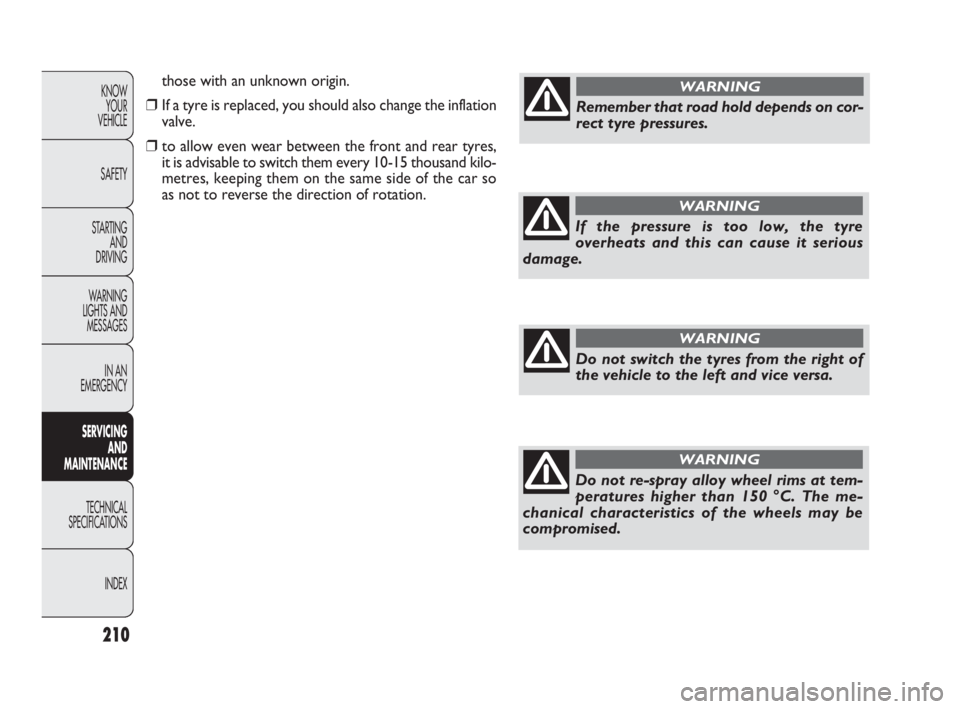
210
KNOW
YOUR
VEHICLE
SAFETY
STARTING
AND
DRIVING
WARNING
LIGHTS AND
MESSAGES
IN AN
EMERGENCY
SERVICING
AND
MAINTENANCE
TECHNICAL
SPECIFICATIONS
INDEX
those with an unknown origin.
❒If a tyre is replaced, you should also change the inflation
valve.
❒to allow even wear between the front and rear tyres,
it is advisable to switch them every 10-15 thousand kilo-
metres, keeping them on the same side of the car so
as not to reverse the direction of rotation.
Remember that road hold depends on cor-
rect tyre pressures.
WARNING
If the pressure is too low, the tyre
overheats and this can cause it serious
damage.
WARNING
Do not switch the tyres from the right of
the vehicle to the left and vice versa.
WARNING
Do not re-spray alloy wheel rims at tem-
peratures higher than 150 °C. The me-
chanical characteristics of the wheels may be
compromised.
WARNING
191-218 DOBLO LUM EN 2e 7.0 24-05-2010 10:40 Pagina 210
Page 212 of 274
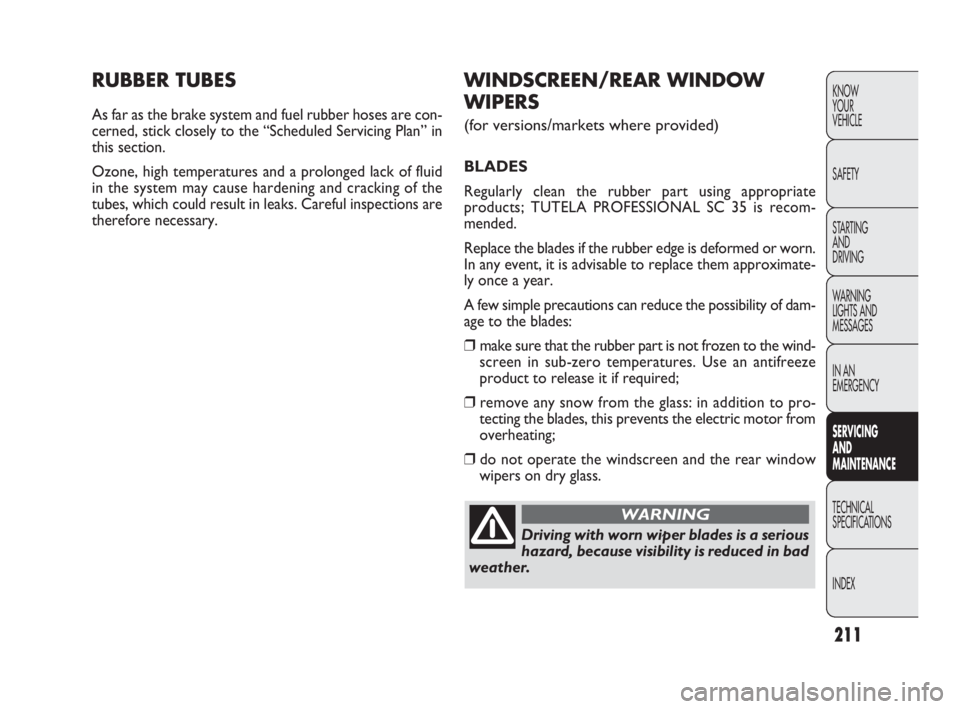
211
KNOW
YOUR
VEHICLE
SAFETY
STARTING
AND
DRIVING
WARNING
LIGHTS AND
MESSAGES
IN AN
EMERGENCY
SERVICING
AND
MAINTENANCE
TECHNICAL
SPECIFICATIONS
INDEX
RUBBER TUBES
As far as the brake system and fuel rubber hoses are con-
cerned, stick closely to the “Scheduled Servicing Plan” in
this section.
Ozone, high temperatures and a prolonged lack of fluid
in the system may cause hardening and cracking of the
tubes, which could result in leaks. Careful inspections are
therefore necessary.
WINDSCREEN/REAR WINDOW
WIPERS
(for versions/markets where provided)
BLADES
Regularly clean the rubber part using appropriate
products; TUTELA PROFESSIONAL SC 35 is recom-
mended.
Replace the blades if the rubber edge is deformed or worn.
In any event, it is advisable to replace them approximate-
ly once a year.
A few simple precautions can reduce the possibility of dam-
age to the blades:
❒make sure that the rubber part is not frozen to the wind-
screen in sub-zero temperatures. Use an antifreeze
product to release it if required;
❒remove any snow from the glass: in addition to pro-
tecting the blades, this prevents the electric motor from
overheating;
❒do not operate the windscreen and the rear window
wipers on dry glass.
Driving with worn wiper blades is a serious
hazard, because visibility is reduced in bad
weather.
WARNING
191-218 DOBLO LUM EN 2e 7.0 24-05-2010 10:40 Pagina 211
Page 213 of 274
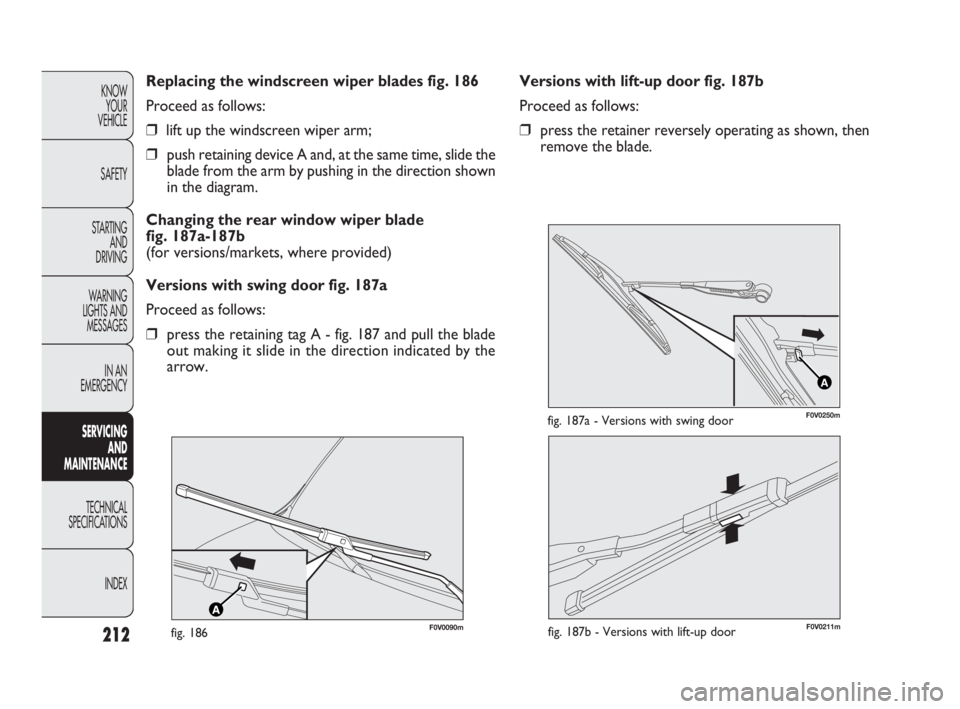
212
KNOW
YOUR
VEHICLE
SAFETY
STARTING
AND
DRIVING
WARNING
LIGHTS AND
MESSAGES
IN AN
EMERGENCY
SERVICING
AND
MAINTENANCE
TECHNICAL
SPECIFICATIONS
INDEX
Versions with lift-up door fig. 187b
Proceed as follows:
❒press the retainer reversely operating as shown, then
remove the blade. Replacing the windscreen wiper blades fig. 186
Proceed as follows:
❒lift up the windscreen wiper arm;
❒push retaining device A and, at the same time, slide the
blade from the arm by pushing in the direction shown
in the diagram.
Changing the rear window wiper blade
fig. 187a-187b
(for versions/markets, where provided)
Versions with swing door fig. 187a
Proceed as follows:
❒press the retaining tag A - fig. 187 and pull the blade
out making it slide in the direction indicated by the
arrow.
F0V0090mfig. 186F0V0211mfig. 187b - Versions with lift-up door
A
F0V0250mfig. 187a - Versions with swing door
191-218 DOBLO LUM EN 2e 7.0 24-05-2010 10:40 Pagina 212
Page 214 of 274
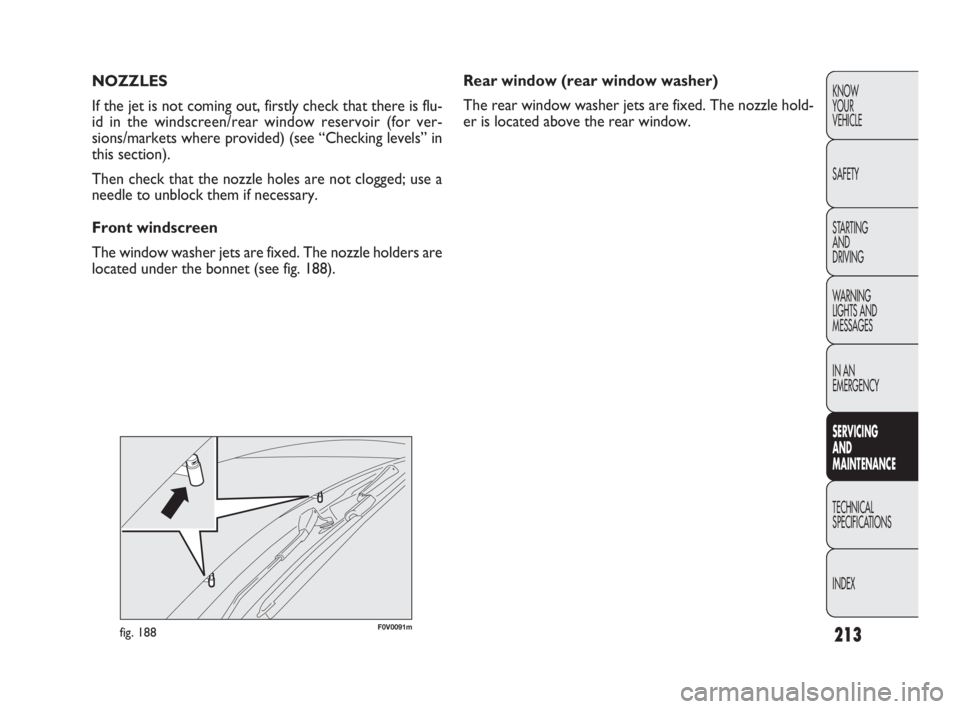
213
KNOW
YOUR
VEHICLE
SAFETY
STARTING
AND
DRIVING
WARNING
LIGHTS AND
MESSAGES
IN AN
EMERGENCY
SERVICING
AND
MAINTENANCE
TECHNICAL
SPECIFICATIONS
INDEX
Rear window (rear window washer)
The rear window washer jets are fixed. The nozzle hold-
er is located above the rear window. NOZZLES
If the jet is not coming out, firstly check that there is flu-
id in the windscreen/rear window reservoir (for ver-
sions/markets where provided) (see “Checking levels” in
this section).
Then check that the nozzle holes are not clogged; use a
needle to unblock them if necessary.
Front windscreen
The window washer jets are fixed. The nozzle holders are
located under the bonnet (see fig. 188).
F0V0091mfig. 188
191-218 DOBLO LUM EN 2e 7.0 24-05-2010 10:41 Pagina 213
Page 215 of 274
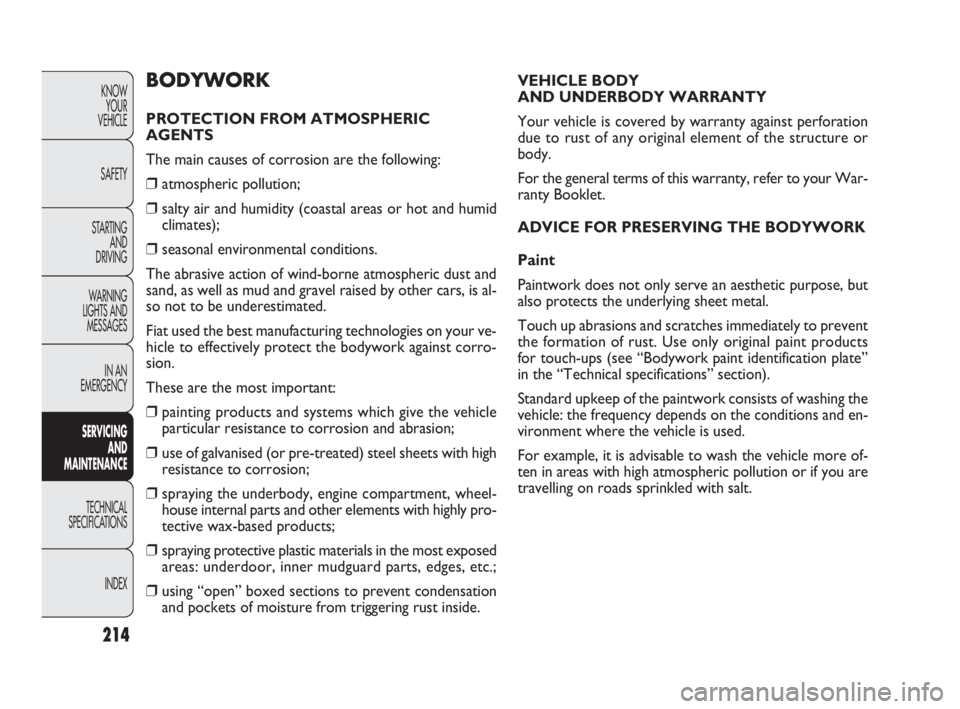
214
KNOW
YOUR
VEHICLE
SAFETY
STARTING
AND
DRIVING
WARNING
LIGHTS AND
MESSAGES
IN AN
EMERGENCY
SERVICING
AND
MAINTENANCE
TECHNICAL
SPECIFICATIONS
INDEX
VEHICLE BODY
AND UNDERBODY WARRANTY
Your vehicle is covered by warranty against perforation
due to rust of any original element of the structure or
body.
For the general terms of this warranty, refer to your War-
ranty Booklet.
ADVICE FOR PRESERVING THE BODYWORK
Paint
Paintwork does not only serve an aesthetic purpose, but
also protects the underlying sheet metal.
Touch up abrasions and scratches immediately to prevent
the formation of rust. Use only original paint products
for touch-ups (see “Bodywork paint identification plate”
in the “Technical specifications” section).
Standard upkeep of the paintwork consists of washing the
vehicle: the frequency depends on the conditions and en-
vironment where the vehicle is used.
For example, it is advisable to wash the vehicle more of-
ten in areas with high atmospheric pollution or if you are
travelling on roads sprinkled with salt.BODYWORK
PROTECTION FROM ATMOSPHERIC
AGENTS
The main causes of corrosion are the following:
❒atmospheric pollution;
❒salty air and humidity (coastal areas or hot and humid
climates);
❒seasonal environmental conditions.
The abrasive action of wind-borne atmospheric dust and
sand, as well as mud and gravel raised by other cars, is al-
so not to be underestimated.
Fiat used the best manufacturing technologies on your ve-
hicle to effectively protect the bodywork against corro-
sion.
These are the most important:
❒painting products and systems which give the vehicle
particular resistance to corrosion and abrasion;
❒use of galvanised (or pre-treated) steel sheets with high
resistance to corrosion;
❒spraying the underbody, engine compartment, wheel-
house internal parts and other elements with highly pro-
tective wax-based products;
❒spraying protective plastic materials in the most exposed
areas: underdoor, inner mudguard parts, edges, etc.;
❒using “open” boxed sections to prevent condensation
and pockets of moisture from triggering rust inside.
191-218 DOBLO LUM EN 2e 7.0 24-05-2010 10:41 Pagina 214
Page 216 of 274
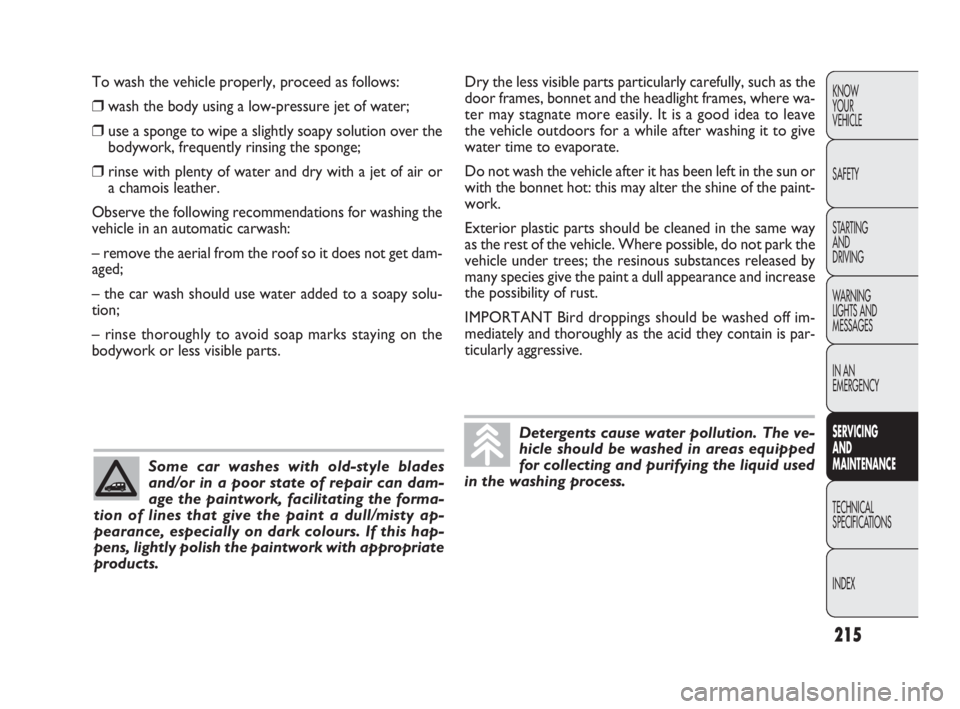
215
KNOW
YOUR
VEHICLE
SAFETY
STARTING
AND
DRIVING
WARNING
LIGHTS AND
MESSAGES
IN AN
EMERGENCY
SERVICING
AND
MAINTENANCE
TECHNICAL
SPECIFICATIONS
INDEX
To wash the vehicle properly, proceed as follows:
❒wash the body using a low-pressure jet of water;
❒use a sponge to wipe a slightly soapy solution over the
bodywork, frequently rinsing the sponge;
❒rinse with plenty of water and dry with a jet of air or
a chamois leather.
Observe the following recommendations for washing the
vehicle in an automatic carwash:
– remove the aerial from the roof so it does not get dam-
aged;
– the car wash should use water added to a soapy solu-
tion;
– rinse thoroughly to avoid soap marks staying on the
bodywork or less visible parts.
Some car washes with old-style blades
and/or in a poor state of repair can dam-
age the paintwork, facilitating the forma-
tion of lines that give the paint a dull/misty ap-
pearance, especially on dark colours. If this hap-
pens, lightly polish the paintwork with appropriate
products.
Dry the less visible parts particularly carefully, such as the
door frames, bonnet and the headlight frames, where wa-
ter may stagnate more easily. It is a good idea to leave
the vehicle outdoors for a while after washing it to give
water time to evaporate.
Do not wash the vehicle after it has been left in the sun or
with the bonnet hot: this may alter the shine of the paint-
work.
Exterior plastic parts should be cleaned in the same way
as the rest of the vehicle. Where possible, do not park the
vehicle under trees; the resinous substances released by
many species give the paint a dull appearance and increase
the possibility of rust.
IMPORTANT Bird droppings should be washed off im-
mediately and thoroughly as the acid they contain is par-
ticularly aggressive.
Detergents cause water pollution. The ve-
hicle should be washed in areas equipped
for collecting and purifying the liquid used
in the washing process.
191-218 DOBLO LUM EN 2e 7.0 24-05-2010 10:41 Pagina 215
Page 217 of 274
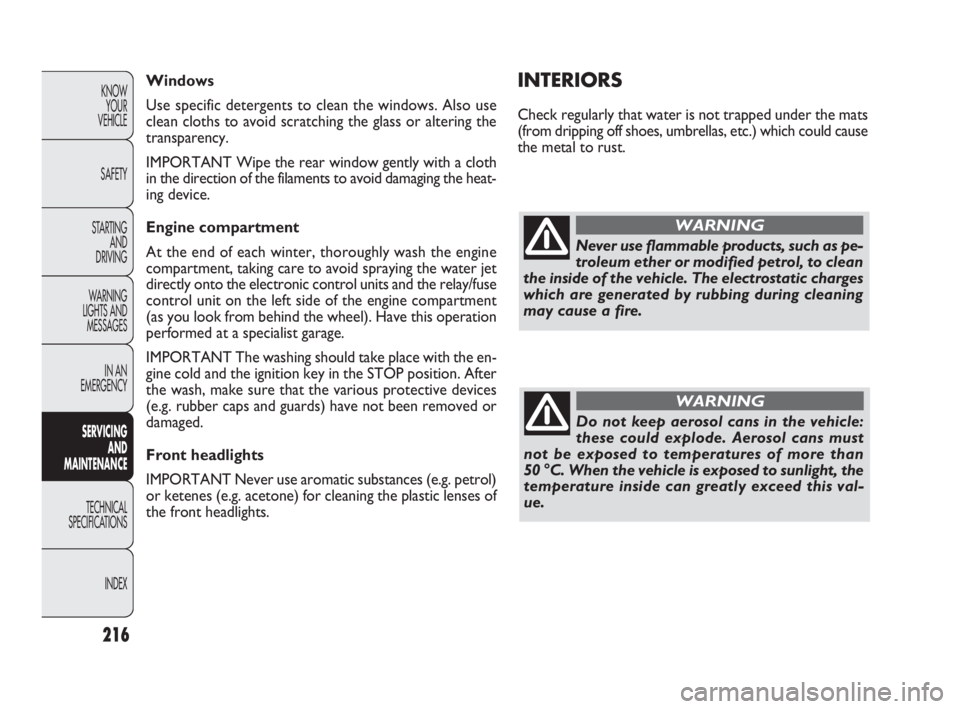
216
KNOW
YOUR
VEHICLE
SAFETY
STARTING
AND
DRIVING
WARNING
LIGHTS AND
MESSAGES
IN AN
EMERGENCY
SERVICING
AND
MAINTENANCE
TECHNICAL
SPECIFICATIONS
INDEX
INTERIORS
Check regularly that water is not trapped under the mats
(from dripping off shoes, umbrellas, etc.) which could cause
the metal to rust. Windows
Use specific detergents to clean the windows. Also use
clean cloths to avoid scratching the glass or altering the
transparency.
IMPORTANT Wipe the rear window gently with a cloth
in the direction of the filaments to avoid damaging the heat-
ing device.
Engine compartment
At the end of each winter, thoroughly wash the engine
compartment, taking care to avoid spraying the water jet
directly onto the electronic control units and the relay/fuse
control unit on the left side of the engine compartment
(as you look from behind the wheel). Have this operation
performed at a specialist garage.
IMPORTANT The washing should take place with the en-
gine cold and the ignition key in the STOP position. After
the wash, make sure that the various protective devices
(e.g. rubber caps and guards) have not been removed or
damaged.
Front headlights
IMPORTANT Never use aromatic substances (e.g. petrol)
or ketenes (e.g. acetone) for cleaning the plastic lenses of
the front headlights.
Never use flammable products, such as pe-
troleum ether or modified petrol, to clean
the inside of the vehicle. The electrostatic charges
which are generated by rubbing during cleaning
may cause a fire.
WARNING
Do not keep aerosol cans in the vehicle:
these could explode. Aerosol cans must
not be exposed to temperatures of more than
50 °C. When the vehicle is exposed to sunlight, the
temperature inside can greatly exceed this val-
ue.
WARNING
191-218 DOBLO LUM EN 2e 7.0 24-05-2010 10:41 Pagina 216
Page 218 of 274
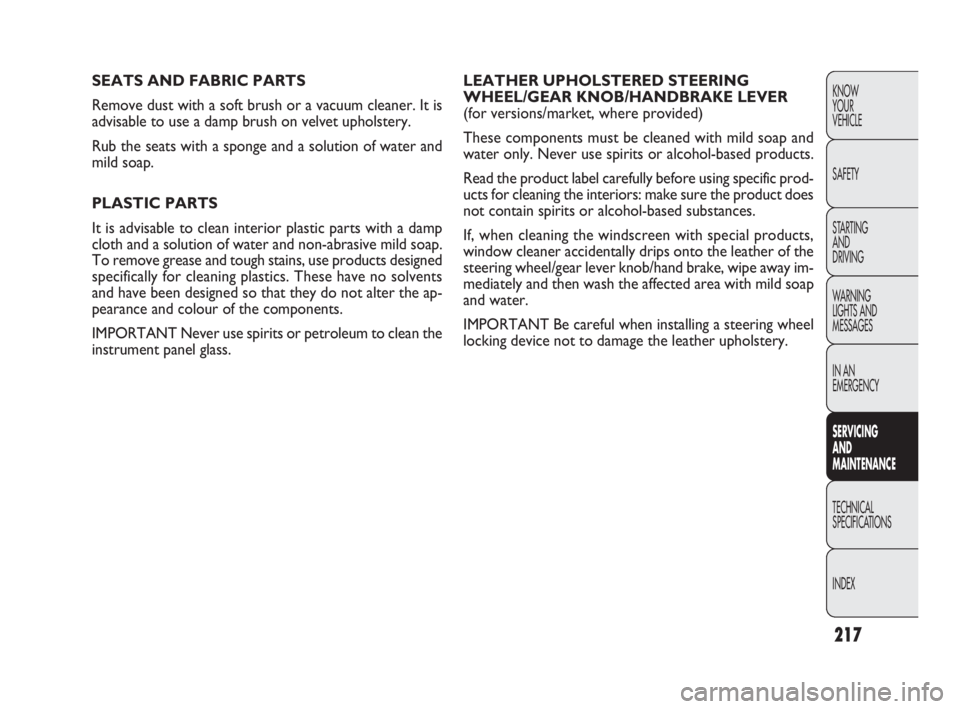
217
KNOW
YOUR
VEHICLE
SAFETY
STARTING
AND
DRIVING
WARNING
LIGHTS AND
MESSAGES
IN AN
EMERGENCY
SERVICING
AND
MAINTENANCE
TECHNICAL
SPECIFICATIONS
INDEX
LEATHER UPHOLSTERED STEERING
WHEEL/GEAR KNOB/HANDBRAKE LEVER
(for versions/market, where provided)
These components must be cleaned with mild soap and
water only. Never use spirits or alcohol-based products.
Read the product label carefully before using specific prod-
ucts for cleaning the interiors: make sure the product does
not contain spirits or alcohol-based substances.
If, when cleaning the windscreen with special products,
window cleaner accidentally drips onto the leather of the
steering wheel/gear lever knob/hand brake, wipe away im-
mediately and then wash the affected area with mild soap
and water.
IMPORTANT Be careful when installing a steering wheel
locking device not to damage the leather upholstery. SEATS AND FABRIC PARTS
Remove dust with a soft brush or a vacuum cleaner. It is
advisable to use a damp brush on velvet upholstery.
Rub the seats with a sponge and a solution of water and
mild soap.
PLASTIC PARTS
It is advisable to clean interior plastic parts with a damp
cloth and a solution of water and non-abrasive mild soap.
To remove grease and tough stains, use products designed
specifically for cleaning plastics. These have no solvents
and have been designed so that they do not alter the ap-
pearance and colour of the components.
IMPORTANT Never use spirits or petroleum to clean the
instrument panel glass.
191-218 DOBLO LUM EN 2e 7.0 24-05-2010 10:41 Pagina 217
Page 219 of 274

page intentionally left blank
191-218 DOBLO LUM EN 2e 7.0 24-05-2010 10:41 Pagina 218
Page 220 of 274
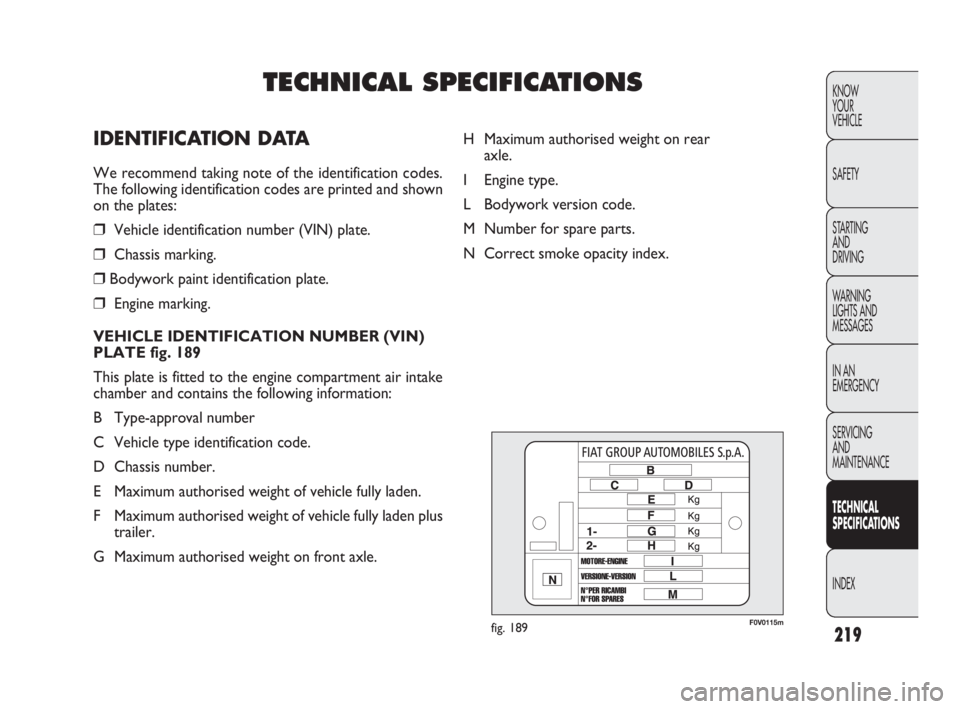
219
KNOW
YOUR
VEHICLE
SAFETY
STARTING
AND
DRIVING
WARNING
LIGHTS AND
MESSAGES
IN AN
EMERGENCY
SERVICING
AND
MAINTENANCE
TECHNICAL
SPECIFICATIONS
INDEX
F0V0115mfig. 189
H Maximum authorised weight on rear
axle.
I Engine type.
L Bodywork version code.
M Number for spare parts.
N Correct smoke opacity index.
TECHNICAL SPECIFICATIONS
IDENTIFICATION DATA
We recommend taking note of the identification codes.
The following identification codes are printed and shown
on the plates:
❒Vehicle identification number (VIN) plate.
❒Chassis marking.
❒Bodywork paint identification plate.
❒Engine marking.
VEHICLE IDENTIFICATION NUMBER (VIN)
PLATE fig. 189
This plate is fitted to the engine compartment air intake
chamber and contains the following information:
B Type-approval number
C Vehicle type identification code.
D Chassis number.
E Maximum authorised weight of vehicle fully laden.
F Maximum authorised weight of vehicle fully laden plus
trailer.
G Maximum authorised weight on front axle.
219-260 DOBLO LUM EN 2e 7.0 27-05-2010 15:09 Pagina 219